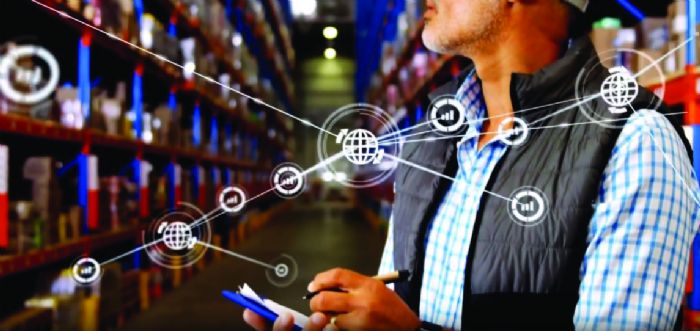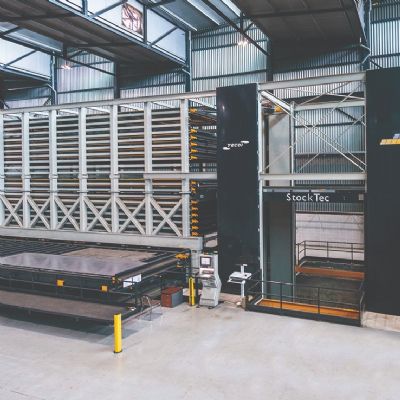While larger manufacturers might employ full digital solutions with all-encompassing software and powerful algorithms to accomplish full shop-floor tracking and automation, others might choose labeling for production tracking, with touchscreens providing information and instructions to guide operators.
“Automatic guided vehicles can route parts and scrap where needed in fully automated operations,” Scarpari says, “but labeling also provides a powerful solution where humans can benefit from a better defined guidance—again, different levels of automation and Industry 4.0 as needed.”
Software packages—for programming, operations, etc.—are available to support manufacturers through implementation and training to provide effective oversight and shop-floor control. And, should problems occur, manufacturers receive direct feedback from equipment through their enterprise resource planning (ERP) or manufacturing execution system (MES) software, and then can respond with instructions to, for example, give a part priority production or reroute WIP.
“The ability to react to unplanned events represents a huge advantage to employing Industry 4.0 and digitization,” says Scarpari. “This technology works well when everything is planned, and also when it’s not.”
In addition, as Scarpari explains, Internet of Things (IoT) technology, an Industry 4.0 component, enables communication with individual machinery to enable preventive and predictive maintenance, leading to planned downtime—a situation much preferred over unplanned downtime.
The Industry 4.0 evolution also allows all of the above to be tested via digital twins, where manufacturers can simulate future implementation of automation and workflow. No need to buy and try, as digital twins can identify problems or present efficient solutions without costly and time-consuming shop-floor trial and error.
WIP Storage a Key Component of Automated Operations
Industry 4.0 technology enables not only retrieving data from a machine to establish a connection with ERP, but also knowing where parts are on the floor and moving WIP automatically upstream and downstream. Salvagnini accomplished this recently on a customer’s shop floor, Scarpari relates, through integration of fabricating equipment and a WIP-storage area with laser-guided vehicles to move pallets along a prescribed path.
The ability to gather, analyze and act on data—an Industry 4.0 staple—allows users to know exactly where a product is and sequence a production path for automation. Note, too, in the above example, the inclusion of the WIP-storage area.
“The industry has stepped back from a concept of extreme lean production, very common a few years ago,” Scarpari says. “Just-in-time production on a machine is fine, but we saw during the pandemic all of the shortages and difficulties in sourcing materials that make lean production no longer the optimal solution. This brings the benefit of some storage, either of WIP or finished products; what matters is knowing exactly what’s in the storage, to have just the right parts in the right quantities; creating virtual warehouses and arrange automatic handling of these components, and mapping their precise location on the floor is key to the success.”
This example illustrates the levels of Industry 4.0 and automation that can be stacked to produce increasingly efficient shop-floor processes, with IoT and automatic feedback of data and analysis via ERP, MES and material requirements planning software, as Scarpari explains, adding new levels of sophistication and performance, minus the difficulty.
“Different levels of the automation can undergo deep and sophisticated integration with incorporation of such software,” he says. “But complex integration does not mean difficult operation. ‘Complex’ just means the consideration and implementation of all elements and inputs that factor into a solution.”
Summarizing Scarpari’s thoughts, Industry 4.0 provides the means for complexity while dispensing with difficulty. And, Industry 4.0 is not a box to be checked, but rather a journey, with countless ways to implement and expand to gain efficiencies in workflow. Scarpari provides details on some of these ways.
For Shops Big and Small
“The old ways of manufacturing just aren’t sustainable economically,” Scarpari says, explaining the need for fence-sitters large and small to accept automation and Industry 4.0 as current and future realities. “Manufacturers must invest in automation—smart automation—to succeed. A whole generation of experienced workers will retire in the next few years. Younger replacements, already difficult to find, prefer a digital world, and manufacturers must appeal to them and adopt digitization to get the most out of them.”
This holds true for large and small operations, Scarpari explains, with all levels of automation and Industry 4.0 available—as outlined above—for any manufacturer’s needs and budget.
“It’s like a ladder…manufacturers can take two or three steps, or just one step at a time,” he says. “Machines can bend without an operator sitting in front of it monitoring or feeding material. This type of automation can free a person for other work, and also free them from physical fatigue and monotony while eliminating the possibility of human error. Such automation, precise and fast, frees labor for other less stressful and more rewarding tasks.
“Then a few years later,” Scarpari continues, “automation might be added, such as a robot for part handling, and integration of blanking and bending. Automation also unlocks the full potential of laser cutting, punching, bending and other fabricating machines, without slowing them down to human speed.”
Don’t consider automation as a huge, lights-out, completely connected factory, Scarpari adds, but as a spectrum. And, combined with Industry 4.0 advantages, users can “collect data and gather insights, and use these insights to drive actionable events,” he concludes. “Manufacturers need to start somewhere along the automation spectrum and grow from there.” MF
See also: Salvagnini America, Inc.
Technologies: Bending, Cutting, Management
 “An efficient machine does not require manual movement of the workpiece during processing, save for loading the blank and unloading the finished product,” Scarpari says. “Integrating the machine with material handling technology for automatic loading and unloading takes it to another level. The next level integrates material handling with all shop-floor operations—this is where Industry 4.0 comes in.”
“An efficient machine does not require manual movement of the workpiece during processing, save for loading the blank and unloading the finished product,” Scarpari says. “Integrating the machine with material handling technology for automatic loading and unloading takes it to another level. The next level integrates material handling with all shop-floor operations—this is where Industry 4.0 comes in.”







